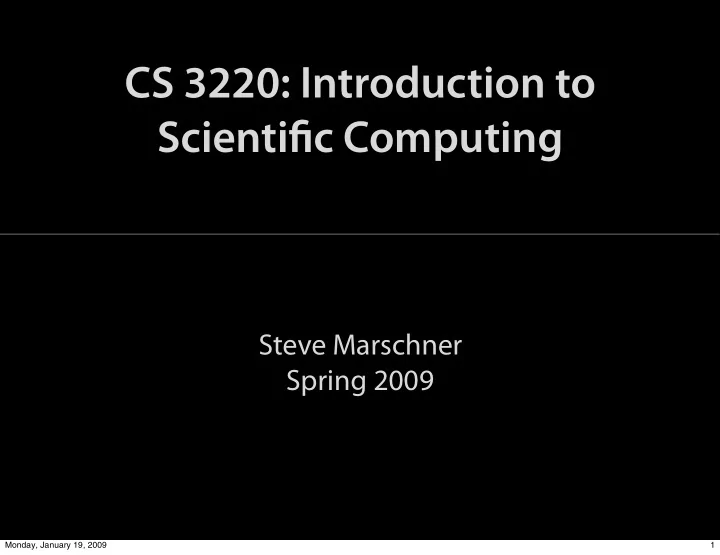

CS 3220: Introduction to Scientific Computing Steve Marschner Spring 2009 Monday, January 19, 2009 1
scientific computing : The use of computers to solve problems that arise in science (and engineering, medicine, …). numerical methods : Algorithms (methods) for solving problems with real numbers by numerical (as opposed to symbolic) means. If your variables represent real-valued quantities, you’re doing numerical computing. Perhaps surprising are: • audio (stream of sound pressure samples) • video (grids of intensity or color samples) • computational geometry (positions in space) • computer graphics and vision (geometry, color, light…) • information retrieval (more on this in a moment) with abundant computing power, more applications are using numerical methods all the time. Monday, January 19, 2009 2
Monday, January 19, 2009 3
Numerical computing in medicine: computed tomography a linear inverse problem Steven W. Smith—dspguide.com U.S. FDA Monday, January 19, 2009 4
Numerical computing in medicine: computed tomography Monday, January 19, 2009 5
Numerical computing in medicine: computed tomography Monday, January 19, 2009 6
Monday, January 19, 2009 7
Numerical computing in climatology: predicting global warming partial differential equations NOAA Monday, January 19, 2009 8
Numerical computing in climatology: predicting global warming Robert A. Rohde Monday, January 19, 2009 9
Monday, January 19, 2009 10
Numerical computing in cars: electronic stability control images from: Liebemann et al. “Safety and Performance Enhancement: The Bosch Electronic Stability Control (ESP)” in The 19th International Technical Conference on the Enhanced Safety of Vehicles (ESV) Monday, January 19, 2009 11
Yaw rate control at work Fifth Gear —demo of Bosch ESP system Monday, January 19, 2009 12
Numerical computing in cars: electronic stability control ordinary differential equations Liebemann et al. Liebemann et al. Monday, January 19, 2009 13
Yaw rate control by braking Fifth Gear —demo of Bosch ESP system Monday, January 19, 2009 14
Monday, January 19, 2009 15
Numerical computing in autonomous vehicles: path planning Mark Campbell—Cornell DARPA Urban Challenge team Monday, January 19, 2009 16
Numerical computing in autonomous vehicles: path planning constrained nonlinear optimization Mark Campbell—Cornell DARPA Urban Challenge team Monday, January 19, 2009 17
Monday, January 19, 2009 Mark Campbell—Cornell DARPA Urban Challenge team 18
Monday, January 19, 2009 Mark Campbell—Cornell DARPA Urban Challenge team 19
Monday, January 19, 2009 20
Numerical computing in games: physics engines ordinary differential equations Crytek GmBH—advertisement for CryEngine 2 game engine Monday, January 19, 2009 21
Monday, January 19, 2009 22
Monday, January 19, 2009 Numerical computing in movies: realistic lighting Hand with Reflecting Sphere. M. C. Escher, 1935. lithograph Gene Miller & Ken Perlin, 1982 23
Numerical computing in movies: realistic lighting numerical integration (quadrature) Real environment, computed objects Jonas Unger Monday, January 19, 2009 24
Monday, January 19, 2009 25
Monday, January 19, 2009 26
Numerical computing in movies: camera tracking numerical differentiation nonlinear optimization Torr & Zisserman, in Vision Algorithms: Theory and Practice , 2000 Monday, January 19, 2009 27
Monday, January 19, 2009 Rendered model added Camera footage Scenespector Systems—VooCAT product demo Zaha Hadid Architects—proposed Guggenheim Vilnius museum 28
Monday, January 19, 2009 29
Numerical computing in information retrieval: Google’s PageRank matrix eigenvalues Idea 1: importance = citation count — simple integer exact answer Idea 2: importance = citation count weighted by importance — now it is a self-referencing definition for a real-valued quantity (and it must be approximated numerically) Computing PageRank works out to be a linear algebra problem: finding the largest eigenvalue of a matrix. Monday, January 19, 2009 30
Monday, January 19, 2009 31
course themes discrete — continuous exact — approximate accuracy, stability, and robustness “Never in the history of mankind has it been possible to produce so many wrong answers so quick ly!” —Carl-Erik Fröberg Monday, January 19, 2009 32
prerequisites calculus, linear algebra some programming experience Matlab CS1132: Transition to Matlab A one-credit course for students who know another language (e.g. Java) and need to map the ideas over to Matlab. Informational meetings: today 3:35 Hollister 307 tomorrow 4:40 Hollister 3:14 Monday, January 19, 2009 33
course mechanics http://www.cs.cornell.edu/Courses/cs3220 Monday, January 19, 2009 34
Recommend
More recommend